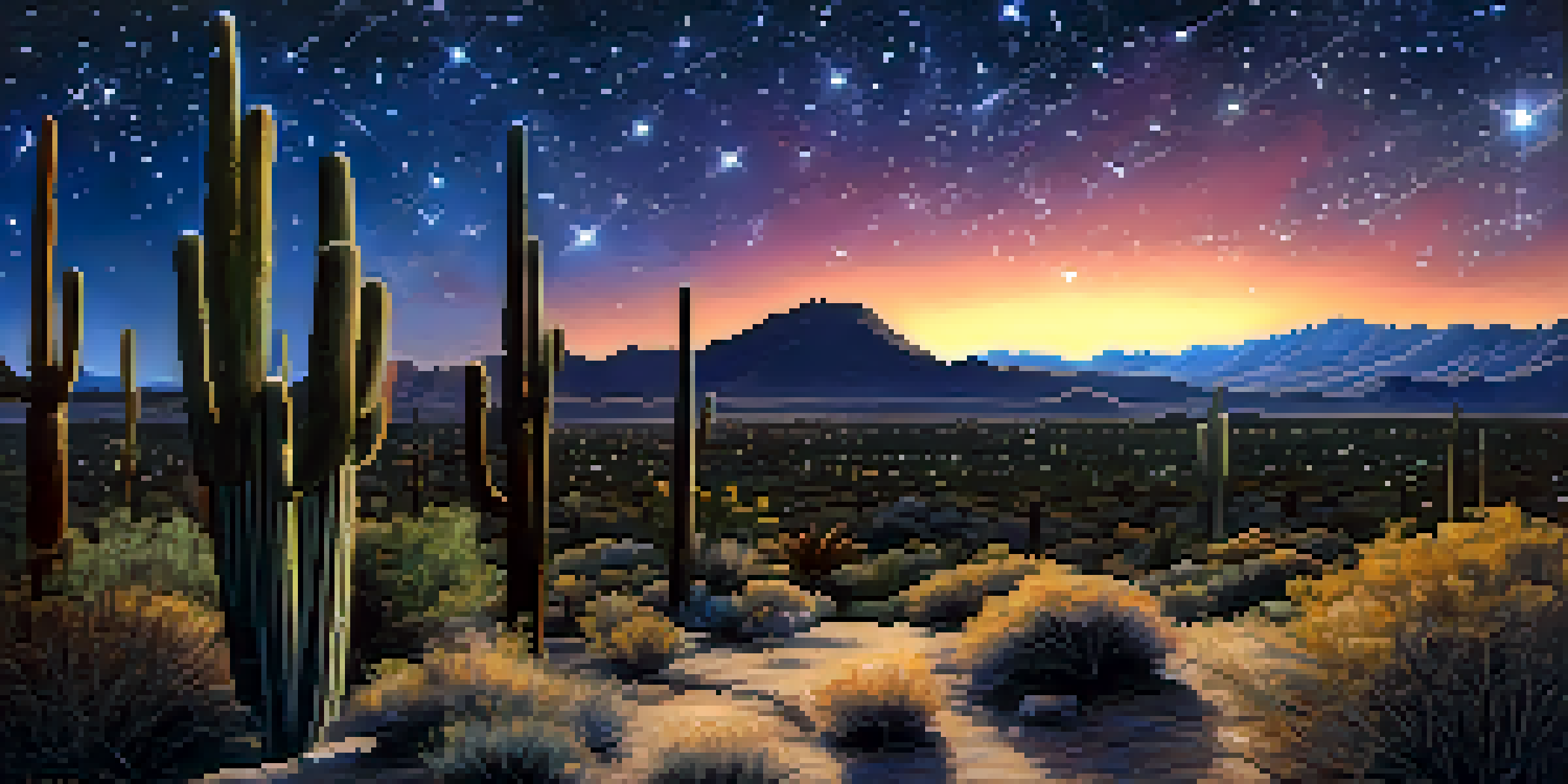Seasonal Stargazing: Best Times to View Tucson's Skies

Introduction to Tucson's Stargazing Experience
Tucson, nestled in the Sonoran Desert, offers a breathtaking backdrop for stargazing. With its clear skies and minimal light pollution, it's a haven for both novice and seasoned astronomers. The area's unique geography not only enhances visibility but also enriches the stargazing experience, making it a must-visit for sky enthusiasts.
The stars are not wanted now; put out every one. Pack up the sky and dismantle the sun. Pour away the sky and sweep up the wood. For nothing now can ever come to any good.
Whether you're a local or a visitor, the beauty of Tucson's night sky will captivate you. From dazzling constellations to shimmering planets, the celestial show is always on display. Understanding the best times to catch these wonders can elevate your stargazing experience to new heights.
In this guide, we'll explore the seasonal highlights of Tucson's night sky, helping you plan your stargazing adventures throughout the year. So grab your telescope or binoculars, and let's dive into the cosmic wonders waiting for you!
Winter: Crisp Nights and Shimmering Stars
Winter in Tucson is a magical time for stargazing, with clear, crisp nights that provide excellent visibility. From December to February, the temperatures drop, but the sky often remains clear, making it an ideal season for observing celestial events. With longer nights, you have plenty of time to enjoy the starry display.

During this season, constellations like Orion and Taurus dominate the sky, showcasing bright stars like Betelgeuse and Aldebaran. Additionally, January brings the Quadrantid meteor shower, a fantastic spectacle that offers a chance to catch shooting stars streaking across the sky. Bundle up in a cozy blanket and prepare for a night of wonder!
Seasonal Stargazing Highlights
Tucson offers unique stargazing experiences throughout the year, with each season showcasing different celestial events and constellations.
The winter sky is also perfect for spotting planets like Jupiter and Saturn, which are prominent during this season. Their bright appearances provide a stunning backdrop to the constellation-rich sky, making winter stargazing a particularly rewarding experience in Tucson.
Spring: A Transition to Celestial Wonders
As winter gives way to spring, Tucson's skies transform, offering a vibrant stargazing experience. From March to May, the weather warms up, and the nights become more comfortable for extended viewing sessions. This season is a great time to explore the sky as it shifts from winter constellations to spring favorites.
Somewhere, something incredible is waiting to be known.
Spring is marked by the appearance of constellations such as Leo and Virgo, with their bright stars lighting up the night. The Lyrid meteor shower in April offers another chance to witness shooting stars, creating a captivating spectacle that shouldn’t be missed. It's like nature's fireworks display, all set against the backdrop of a clear Tucson sky.
Additionally, spring is an excellent time to observe the Milky Way as it begins to rise earlier in the evening. Grab your friends and family, and head out to a dark spot to marvel at this spectacular band of stars stretching across the sky, a true reminder of the universe's vastness.
Summer: Warm Nights and Celestial Richness
Summer in Tucson brings warm nights filled with an abundance of stargazing opportunities. From June to August, the skies are alive with activity, and the warm weather invites you to spend more time outdoors. While monsoon season might bring occasional clouds, there are plenty of clear nights to enjoy.
This season is perfect for exploring the summer constellations, particularly Scorpius and Sagittarius. These constellations are home to some of the brightest stars and interesting deep-sky objects, including globular clusters and nebulae. It's like a cosmic treasure hunt when you start identifying these stellar gems.
Tips for a Great Stargazing Night
Choosing dark locations, using star charts or apps, and dressing appropriately can significantly enhance your stargazing experience in Tucson.
Moreover, the Perseid meteor shower peaks in August, providing a thrilling chance to see meteors blazing through the sky. Set up your blanket and lie back, allowing the beauty of the night to envelop you as you watch the universe put on a dazzling show.
Fall: A Breathtaking Celestial Showcase
Fall is a delightful time for stargazing in Tucson, as the temperatures cool down and the skies remain mostly clear. From September to November, you can enjoy crisp nights filled with brilliant stars and engaging celestial events. This season is particularly exciting for astronomy enthusiasts, with various phenomena to witness.
One of the highlights of fall is the Orionid meteor shower in October, which can be stunning as it peaks with numerous shooting stars. As you gaze upward, you'll also see the return of familiar winter constellations like Orion, making it a beautiful transitional period in the sky. Each night offers a new opportunity for discovery.
Additionally, fall is a great time to spot planets like Mars and Venus, which shine brightly against the autumn backdrop. With a little planning, you can create the perfect stargazing night that combines celestial exploration with the beauty of Tucson's landscapes.
Essential Tips for Stargazing in Tucson
To make the most of your stargazing experience in Tucson, consider a few essential tips that can enhance your adventure. First and foremost, choose a location away from city lights. Parks and open areas in the surrounding regions offer dark skies that are perfect for observing celestial events. The less light pollution, the more stars you'll see!
Next, bring along a star chart or a stargazing app on your smartphone. These tools can help you identify constellations, planets, and other astronomical phenomena. They make it easy to navigate the night sky, turning your stargazing into a fun and educational experience.
Community Engagement in Astronomy
Tucson's astronomy community provides numerous resources, events, and workshops for stargazers of all levels to deepen their understanding and enjoyment of the night sky.
Lastly, don't forget to dress appropriately for the weather. Tucson nights can get chilly, especially in winter and fall. Layering your clothing will keep you comfortable and allow you to focus on the beauty above rather than the cool air.
Community Stargazing Events and Resources
Tucson is home to a vibrant astronomy community, offering various events and resources for stargazers of all levels. Local observatories and astronomy clubs often host public viewing nights, where you can join fellow enthusiasts and explore the sky through telescopes. It's a great way to learn from experienced astronomers and share your passion with others.
In addition to organized events, Tucson's libraries and community centers frequently offer workshops and lectures on astronomy. These programs provide valuable knowledge about stargazing techniques, celestial navigation, and the science behind the stars, enriching your overall experience.

Don’t forget to check out online forums and social media groups dedicated to Tucson's stargazing community. These platforms are excellent for staying informed about upcoming events, finding fellow stargazers, and sharing your discoveries from the night sky.
Conclusion: Embrace the Stargazing Journey
Stargazing in Tucson is more than just an activity; it's a journey into the wonders of the universe. Each season offers unique opportunities to explore the night sky, witness celestial events, and connect with nature. With its stunning landscapes and clear skies, Tucson is a dream destination for anyone who seeks to experience the beauty of the cosmos.
As you embark on your stargazing adventures, remember to appreciate the awe and inspiration that the night sky brings. Whether you're gazing at constellations, spotting meteors, or even discovering a new planet, every moment spent under the stars is a reminder of the vastness of the universe.
So gather your friends and family, pack your blankets and telescopes, and embrace the stargazing journey. The skies of Tucson are waiting to reveal their secrets to you, one star at a time.